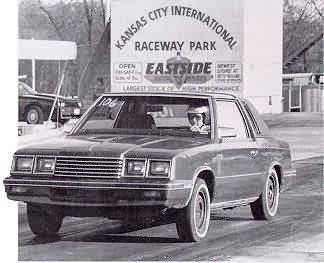| 13 Seconds next ... How to build a Mustang-stomping Chrysler
Turbo 4 ... BY TOM HAND. |
Most Mopar fans are convinced that performance stopped in 1971 with the
death of the Hemi. I'm not one of those, but I admit the new breed of cars
from Chrysler has to be attacked from a slightly different but somewhat
similar angle. I've grown up with a couple of 340 4-speed cars, and I've
found there are a lot of little tricks that add up to a big performance
increase, even on the new front-wheel-drive cars. Chrysler has stayed with
the FWD platform since the first K-cars in 1981, and it didn't appear that
they were going back to the rear-wheel-drive high performance cars of the
'60s. I've always enjoyed the sleeper cars, such as 340 Darts and Dusters,
so I chose as my '80s sleeper a 1984 Dodge 600 with a turbocharged 2.2
liter (135 cubic inch) engine and an automatic transmission. A quick look
at the Dodge reveals air conditioning, tilt wheel, six-speaker AM/FM cassette
and a rear window defroster. The Dodge 600 weighs about 2680 pounds, the
turbocharged 2.2 is rated at 142 hp, and the automatic transmission has
a gear ratio of 3.02-to-1. I chose as a realistic goal a 14-second elapsed
time and 90 mph in the quarter mile. Before any major power improvments
were undertaken, I thought it wise to inspect the lower end of the engine
and at the same time install a higher volume oil pump. After the oil pump
and pan were in, the cylinder head was pulled, cleaned up and reinstalled
with new head bolts.
To check out the car and establish a baseline, I ran it at the strip until
consistent results were acheived. These first runs were exactly as expected
and comparable to the original Chrysler advertised figures. The slowest
run was a 17.14 at 79.6 mph and the quickest was a 16.85 at 80.8 mph. Not
particularly exciting but certainly promising, as the horsepower-to-weight
calculations showed the engine to be producing at least 127 hp. (Some errors
can be expected in the calculated values, compared with the Chrysler rating
of 142 hp, because the standard tables I used aren't as accurate when working
with front-wheel-drive cars.)
In anyone's modification plan, the first step should be the easiest and
most cost-effective. In the case of "computer controlled" engines, it is
true that changing the chip (or in Chrysler's case, the Logic Module) will
produce a substantial gain in horsepower. Mopar Performance sells a Logic
Module for the '84 turbos that installs in minutes, provides a more aggressive
spark timing curve, a richer fuel mixture and higher rpm engine cutoff,
and allows a boost pressure increase from 7.2 psi to about 10.0. Owners
who install this computer chip will find that 92 octane fuel is not high
enough to prevent detonation. I solved this problem by mixing 100 octane
low lead aviation fuel with unleaded premium. Beware of the likelihood
of poisoning the oxygen sensor and the catalytic converter with large volumes
of this fuel. Drag strip elapsed times showed a great deal of improvement,
with the slowest time of the day being a 16.14 at 83.5 mph and the best
a 15.90 at 94.8 mph. Calculations showed the Logic Module to be worth about
15 hp. Not only was the 600 coupe's performance respectable, it could now
run with automatic transmission-equipped Z28s, Trans Ams and Mustangs.
 |
The Logic Module, found under the right kick panel inside all Chrysler
turbocharged cars, is the brains behind all the engine functions. |
After studying some basic turbocharger theory, I decided a reduction of
exhaust backpressure and a "streamlining" of the air intake system would
give some more performance gains. I bought some 2.5 inch diameter 409 series
stainless steel tubing, and a custom exhaust shop bent a new system for
me that used a stainless steel Sonic Turbo muffler and had no provisions
for a catalytic converter. Without the converter, a system like this has
to be considered "strictly off-road," so applicable laws should be checked
before using it on the street.
| Air cleaner cover was polished in area indicated by
pointer. |
 |
 |
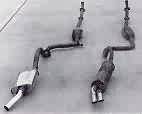 |
Stock exhaust (right) was replaced with a custom-bent system using
2.5 inch stainless steel tubing, a Sonic Turbo muffler and no provisions
for a catalytic converter. |
I removed the turbocharger compressor inlet elbow, the air cleaner hose-to-throttle
body adapter and the air cleaner cover, eliminated all the casting flash
and polished them internally. Installation was completed with a K&N
air filter element. The intake modifications I performed were similar to
what a person would do to an intake manifold on a V8 engine. However, I
had an easier time since most of my components were plastic. A road test
revealed a remarkable difference in driveability, and it was obvious the
drag strip times would correlate. The strip times confirmed this: a slowest
time of 15.75 at 87.71 mph and a fastest of 15.65 at 88.75 mph. Horsepower
calculations showed the better-breathing 2.2 was providing at least 165
hp; that's another 20 on top of the 18 added by the Logic Module and higher
octane fuel. Since my 2.2 turbocharged engine was approximately 30 percent
more powerful now than it was in its stock configuration, I began to get
concerned about driveline breakage. A little research educated me a bit.
The older FWD transaxles had a differential mounting configuration that
was not capable of sustaining wide open throttle, drag strip-style starts.
I also learned that Chrysler had corrected this problem in the '87 and
newer automatic transaxles.
The third step in my quest for a 14-second FWD automatic was the hardest
to complete and the most expensive. I was aware of the transaxle redesign
in the 1987 and newer Chrysler turbo cars, so I limited my search to one
of those. After its aquisition, I had the ring and pinion changed from
the stock 3.02-1 ratio to a lower 3.22-1. The torque converter used was
built to specs provided by a Chrysler torque-converter expert, and I acquired
a flywheel to attach this new 4-bolt converter to my existing 6-bolt crankshaft
flange and 3-bolt converter. (Note '84s used a 6-bolt crank flange and
3-bolt converter; newer vehicles have an 8-bolt crank flange and a 4-bolt
converter.) The transaxles for 1987 and later turbocharged Chrysler cars
drive through stronger axle shafts, so these too were replaced.
| Installation of the new, larger drive axle (left) led
to a previously impossible condition: wheelspin! |
 |
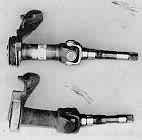 |
New intermediate shaft (top) replaced the original, smaller piece. |
Installation of the new transaxle was a six-hour job that went relatively
smoothly. After completion, a few trips around the block confirmed what
I had hoped for. My Dodge 600 was now capable of wheelspin from a slow
roll- something that was not possible before the transaxle change. Before
my next drag strip test, I installed a 3 inch air duct from below the front
valance to the air box in order to provide an ample supply of cold air.
I again mixed the fuel to obtain sufficient octane. My first run surprised
even me with a 15.31 at 88.9 mph. The transaxle had obviously made a great
improvement in bottom end performance, because now I was fighting wheelspin.
Later in the evening I had back-to-back runs of 15.17 at 90 mph, and it
was obvious 14-second elapsed times were only a quicker start away. Horsepower
was calculated to be about 170, an overall improvement of 43 so far. After
about 4000 miles and 50 passes at the strip, I began to notice a buzzing
noise from the converter area. I pulled the transaxle and had the converter
cut apart, and it's here that the damage was found. I had wiped out the
thrust washer assembly that takes all the load during high stall conditions.
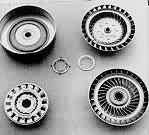 |
Special torque converter was built to specs provided
by a Chrysler torque converter specialist. Two failed thrust washers are
at center. |
|
I settled on a new torque converter sold by Turbo-Action (as well as
Mopar Performance) that has needle bearings instead of the bronze and babbit
thrust washers. It is slightly tighter than the factory unit I had installed
with the heavier duty transaxle. The new converter required a few modifications
before I could install it. The early transaxle that it was designed for
used an oil pump that has a drive gear with two tabs in its inside diameter,
which the converter hub engages. My later-transaxle oil pump has two flats
on its i.d., so I had to have a machine shop mill corresponding flats on
the hub of my new converter. This converter has three mounting bolts, so
the original 3-bolt flywheel was reinstalled. The Top Dead Center mark
was also made more obvious (2.2s are timed through a hole in the bellhousing
by a mark machined on the converter). Back at the strip, it appeared that
the tighter converter was exactly what I needed to kill some of the 2.2s
low end torque. Best time of the day was a 15.05 at a slightly slower 89.0
mph. I still, however, could not get into the 14s. My only hope was to
find more horsepower. My Logic Module already was running the engine with
maximum boost, fuel and timing. Luckily, I stumbled across a rather devious
but very intelligent auto-oriented computer head who fabricated a new chip
for my existing module. This one would allow as high as 14 psi of boost;
however, my stock injectors are only safe up to about 12 psi. I set the
boost at 11.5 via various tuned bleed-off orifices and went back to the
strip. First run success finally arrived with a timeslip that read 14.96
at 90.0 mph. After a couple more runs, I stopped with a best time of 14.77
at 90.7 mph. The last race for me in 1988 was our Second Annual Mopar Day
at Kansas City International Raceway on October 16. The weather was good,
with the temperature at 80 degrees, relative humidity at 35 percent and
the barometer at 29.98. Since the new Logic Module chip would allow temporary
overboost, I opened the exhaust system. (The other modules had only minimal
tolerance for overboost, and opening the exhaust would consistently let
the turbo spin up quicker than the wastegate could control. This generally
cause the overboost condition.) This was going to be a good day to compare
the performance of my '80s FWD musclecar with the '60s and '70s Mopar RWD
musclecars. The initial run was an exciting 14.48 at 93.9 mph. Horsepower
calculated to about 192; the new devious box combined with open exhaust
increased the power another 22 hp, but lowering the boost put it back to
a safer 182. Subsequent runs were all between 14.47 and 14.51. As the day
progressed, it appeared that my injectors were not supplying the fuel,
so I lowered the boost slightly and dialed the car in on a 14.60, and the
mph stabilized at 92.0. I let a very good (and consistent) friend drive
the 600 in the bracket race, and he piloted it to a runner up finish in
the 13.00 to 14.99 class. Who would have thought that an '84 Dodge 600
four-cylinder would be at the strip, much less competing the same class
with just about every other factory Mopar musclecar ever made?
After the 14.40s, I finally was as far as I figured I could get with my
existing non-intercooled 2.2 setup. However, I couldn't stop at 93 or 94
mph. A few more calculations showed 98 mph was in reach, with only 200
hp needed to get there. My injectors would not support the 200 hp attempt,
and without nitrous oxide I knew I was at the end of my road. But luck
would again go my way, as I was able to purchase a complete intercooler
manifold, intercooler and all the associated hardware needed to adapt it
to my vehicle. The first step was to disassemble my old hardware, While
the head was off, I checked and cleaned the valves and installed new valve
seats. I also drilled and tapped the block for the new 11 mm head bolts
that give the much-needed clamping power. The new intake I installed was
a two-piece tuned unit that changed the torque peak to a lower rpm level--just
exactly what my automatic-equipped 600 needed. While it was off the car,
I also matched the two halves of the intake to the gasket, therefore matching
the runners, much like one would match the intake to the heads on a V8.
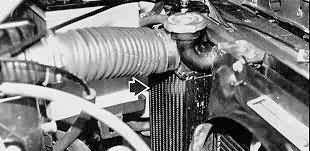 |
| Intercooler (arrow) was borrowed from an '87 Daytona
and instantly improved ET and mph in the quarter mile. |
Surprisingly, everything bolted on my 1984 600 K-Body, even though it
was intended for an '87 G-Body (Daytona). I did, however, have a number
of items that needed to be modified and/or removed. Initially the new throttle
body was a big problem. However, my advisor in this new project engineered
an aluminum sleeve that let my old 1984 motor-driven "valve" idle motor
fit onto the new throttle body, which originally used a motor that pushed
a plunger in and out of the orifice in the body. Right after I thought
things were solved with the throttle body-idle motor problem, I realized
the hood would not shut, as the water drain trough sits on top of the new
tuned intake. I left the room as my dad used his metal cutters to trim
off the offending sheetmetal. I guess this is how people feel when they
cut holes in their hoods to clear blowers and carburetors.
My old radiator had two additional parts that the new intercooler radiator
assmebly didn't. One was a hose nipple that was the return for the heater
hose, and the second was a female pipe fitting that accepted the radiator
fan thermostat switch-sensor. I bought a 4 inch long piece of 1.5 inch
diameter pipe and welded on the correct size nipple for the heater hose
and the female pipe fitting to accept the thermostat switch-sensor. I had
to buy an '87 Turbo II Daytona lower radiator hose and use the smaller
diameter section of it on one side of my new 1.25 inch adapter. Then I
cut my old hose and attached it to the other side of the adapter. Software
problems always surface with computerized items, and this project was no
exception. However, my devious but auto-oriented computer head friend corrected
my Logic Module to feed the new high-flowing injectors and allow for the
100 degree of (average) temperature drop air that the intercooler would
provide.
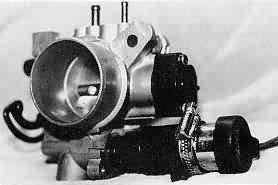 |
| Opening in old idle motor connects to a custom-fabricated
aluminum sleeve. |
After some minor tuning on the throttle body to bleed more air through
the idle motor assembly, I was able to achieve a respectable idle. It's
amazing how much torque this combination yields. I couldn't believe how
responsive the four cylinder really felt. It sort of reminded me of a 340
automatic Dart I once had. After a two-month proving, I was ready for the
strip. I left my exhaust hooked up and the boost set at 10 psi. I ran only
92 octane unleaded Amoco fuel. The very first run was a 14.76 at about
94 mph but with a lot of wheelspin. Before the intercooler, it took 11.5
to 12 psi and good fuel to even touch the 94 mph range. I cranked the boost
up to 12 to 12.5 psi and the times dropped to 14.40 at 96 mph. The final
runs were made with the exhaust opened, and even a Grand National was surprised
with my best time of 14.14 at 98 mph. Later runs would raise the speed
to 99 mph, but ET stayed around 14.20. When I calculated the horsepower,
it worked out to some 200 to 205. What's more, the times and mph reflected
another resounding change--all of this from a car that started out turning
17.14 at 79 mph.
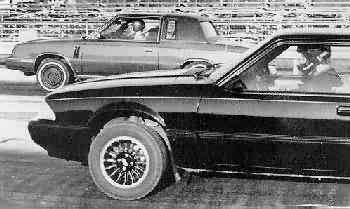
I'm always a bit skeptical when I read an article such as this on performance
modifications. There are always bad things that go hand in hand with the
good, and this project was no different. I'll give a brief synopsis of
the disadvantages I noted. The Logic Modules improve power a great deal,
but very high octane fuel is required. The second special module I ran
the 14s with is not yet commercially available, but there are many fuel
enrichment devices that could possibly achieve the same results. The Chrysler
electronic system adapts to any type of fuel by using a detonation sensor
to control pre-ignition, but the subsequent retardation of total advance
is very noticable in a seat-of-the-pants feel. The new exhaust system is
not any louder than the original one, but the absence of the catalytic
converter makes it illegal for street use. Enough said. I still strongly
feel that 13.90s at 98 mph are possible, but I'm not sure my Michelin 195/70R-14
whitewalls will supply the needed traction. Even in 95 degree weather,
the intercooler allows me to run only 92 octane fuel without detonation
at 12 psi boost, and this provides more than enough torque to roast the
front tires. At the strip, I've been posting about a 65% success rate against
5.0 liter mildly modified Mustangs, and even the semi-stock Grand Nationals
can't consistently beat me. I'd have to say I'm satisfied with the 3 second
decrease (17.14 to 14.14) and 20 mph increase in quarter mile performance.
Even the fuel economy decrease from the stock 27 mpg highway/20 mpg city
to the 21 highway/16.5 city that the car attains now isn't all that major.
I'd like to thank Dr. Prom for the electronics wizardry, Dr. Nosh for
the transmission information and Dr. Bob for the adaptation guidelines.
Without the help of these three, I couldn't have met and exceeded my original
14 second, 90 mph goals. |
